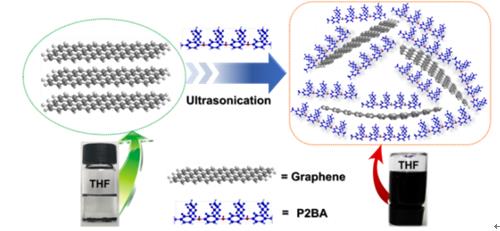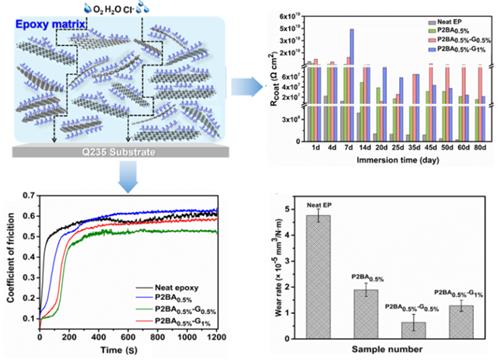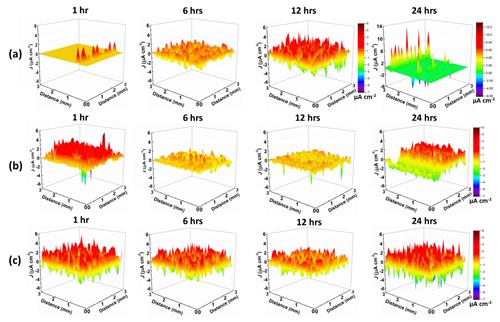Study on the Preparation of Graphene Dispersion and Its Multifunctional Organic Composite Coatings in Ningbo Institute of Materials

Figure 1. Preparation of graphene dispersion

Figure 2. Corrosion and wear resistance of graphene-modified composite coatings

Figure 3. Structure and electron micrograph of graphene hybrids; corrosion protection mechanism and corrosion resistance of hybrid composite coatings

Figure 4. (a) Blank aqueous coating (b) Conductive polymer composite coating (c) Local current density distribution at the defect of the graphene hybrid composite coating
Graphene has a unique nanosheet structure and excellent electrical conductivity, mechanical properties and barrier properties. It is a research hotspot in the field of composite materials (coatings) in recent years. However, graphene, due to its high specific surface area and interlaminar force, tends to agglomerate in the polymer resin matrix, failing to fully exert the excellent characteristics of graphene monolayer or few layers, and restricting its application in many fields.
The organic functional coating team under the guidance of Wang Liping and Zhao Haichao, researcher of the Marine Functional Materials Team of the Ningbo Institute of Materials Technology and Engineering, Chinese Academy of Sciences, is dedicated to the chemical and physical modification of graphene, as well as the preparation and research of graphene multifunctional composite coatings. Based on the π-π interaction between graphene and conductive polymers, the team prepared soluble conductive polymers by controlled polymerization, and combined ultrasonic dispersion to achieve liquid phase exfoliation of graphene, which was dispersed in conventional organic solvents. Up to 5 mg/mL, the average thickness of graphene sheets after exfoliation is 2-3 nm (Figure 1). Through the passivation of the conductive polymer on the coating substrate and the shielding and self-lubricating effect of the two-dimensional nanosheet structure of graphene, only a small amount of peeled graphene (0.5%) epoxy composite coating is provided with corrosion resistance and lubrication. Both sex and wear resistance have been greatly improved. Related work was published on Carbon and applied for national invention patents.
The hydrophobicity of graphene makes it difficult to achieve dispersion in water and aqueous resins. The team prepared water-soluble conductive polymer latex nanoparticles as intercalation agent for graphene by microemulsion polymerization (Fig. 3), and achieved stable dispersion of graphene two-dimensional nanoplates in aqueous resins, and preparation of aqueous epoxy coatings. In the layer, graphene forms a physical barrier layer in the matrix to prolong the diffusion path of the corrosive medium and slow down corrosion; the conductive polymer can generate a dense passivation film on the metal surface, inhibit corrosion, and synergistically improve the corrosion resistance of the composite coating, and The scanning vibration electrode technique (SVET) study shows that the coating has self-healing properties (Figure 4). Related work was published on ACS Applied Material & Interfaces.
The research work was supported by the "Hundred Talents Program" of the Chinese Academy of Sciences, the Frontier Scientific Research Program of the Chinese Academy of Sciences, the major technology of graphene in Zhejiang Province and the funding of the Natural Science Foundation of Zhejiang Province.
POM plastics,lalso named Acetals(paraformaldehyde) (semel - Stirling),
English name: Polyoxymethylene (Polyformaldehyde),POM mainly has antistatic POM, conductive POM,POM+PTFE SHEET.
POM plastics (polyformaldehyde resin) definition: polyformaldehyde is a linear polymer with no side chain, high density and high crystallographic properties.
According to the different chemical structures in the molecular chain, there are two kinds of homoformaldehyde and copolymerization.
One of the synthetic resin, also known as polyformaldehyde resin, POM plastic, and steel, etc.
POM/Acetals Plastic is a kind of white or black plastic granule with high hardness, high steel and high abrasion resistance.
Mainly used for gears, bearings, auto parts, machine tools, instruments, etc.
Advantages:
1. Excellent abrasion and creep resistance property;
2. High dimensional and shape stability;
3. Retains toughness under low temperature (-40°C);
4. Resistant to organic solvents; Insoluble under normal temperature;
5. Thermal deformation temperature is close to that of PC plastic, PTFE plastic and nylon plastic;
6. High compressive strength, second only to Glass Fiber;
7. Good sliding property; wear resistant; non-water absorbent;
Disadvantages:
1. Not resistant to acids, especially to mineral acids;
2. Not resistant to UV;
3. Not self-extinguishing, and thus must be kept away from fire;
4. Not resistant to impact.
Applications:
1. Sliding parts: bearing and lining, roller, conveyor chain;
2. Precision mechanical components: gear, cam, coupler, idler roller;
3. Waterproof components: impeller, pump case, gasket;
4. Electrical parts: guide pulley, spring lock;
5. Fixture, lever, handle, knob and other jig materials.
Modified POM/Acetals Plastic
reinforced POM/Acetals Plastic
Main reinforced material such as glass fiber, glass or carbon fiber, and glass fiber is the most commonly used, the enhanced mechanical performance can be improved 2 ~ 3 times, heat distortion temperature increased by more than 50 ℃.
High lubrication POM POM/Acetals Plastic
In POM, graphite, F4, molybdenum disulfide, lubricating oil and low molecular weight PE are added to improve the lubrication performance
Combustion characteristics: easy to burn, continue to burn after fire, the upper end of the flame is yellow, the lower end is blue, and the melting drop, the strong irritating formaldehyde flavor, the fish smell
Specification: the thickness of sheet material can be produced from 0.3mm to 1.9mm, the normal width is 600mm, the width cannot exceed 1200mm, the length is not limited.
The thickness of plate can be produced from 2mm to 180mm, the usual specification of 2-10mm is 1000mm* 2000mm, and the commonly used specification of 10-180mm is 600*1200mm.
POM/Acetals Plastic can also be customized according to requirements, and the width cannot exceed 1200mm, and the length is not limited.and The diameter of the rod can be produced from 2mm to 250mm, the length is 1 meter, and POM/Acetals Plastic can be ordered to be more than 3 meters in length.
Color: Black ,white beige and brown, can also be made another color, and the color order is 500KG.
Modified varieties: can be added to the glass fiber, copper powder, and molybdenum disulfide enhancement plate according to customer's requirements.
Add antistatic agent to the permanent plate, the volume resistance value of 10 to the 6 to 9 power.
Add flame retardant to the flame retardant board from UL 94v-0 to HB combustion grade, and other modification requirements are required to customize various additional properties according to the actual use of the customer.
Product certification: most environmental certification reports and safety reports for raw materials, such as SGS report, CTI report, UL report, MSDS safety information, etc.
POM/Acetals/Derlin Plastic Sheet
POM Plastic Sheet,Copolymer Acetal Sheet,Acetal Plastic Rod,Extruded Antistatic POM Sheet
Dongguan Noegem Plastic Products Co.,Ltd , http://www.noegempLastic.com